Promoting and Building a Strong Partnership with Parents/Caregivers
In this edition of the LINC Blog, LINC Graduate Teresa Callanan explores the importance of building strong partnerships with parents and caregivers. She reflects on how open communication, trust, and collaboration between educators and families play a vital role in supporting each child’s holistic development. From sharing daily updates to fostering an open-door policy, Teresa highlights practical ways to strengthen these connections for the benefit of children’s learning and well-being.
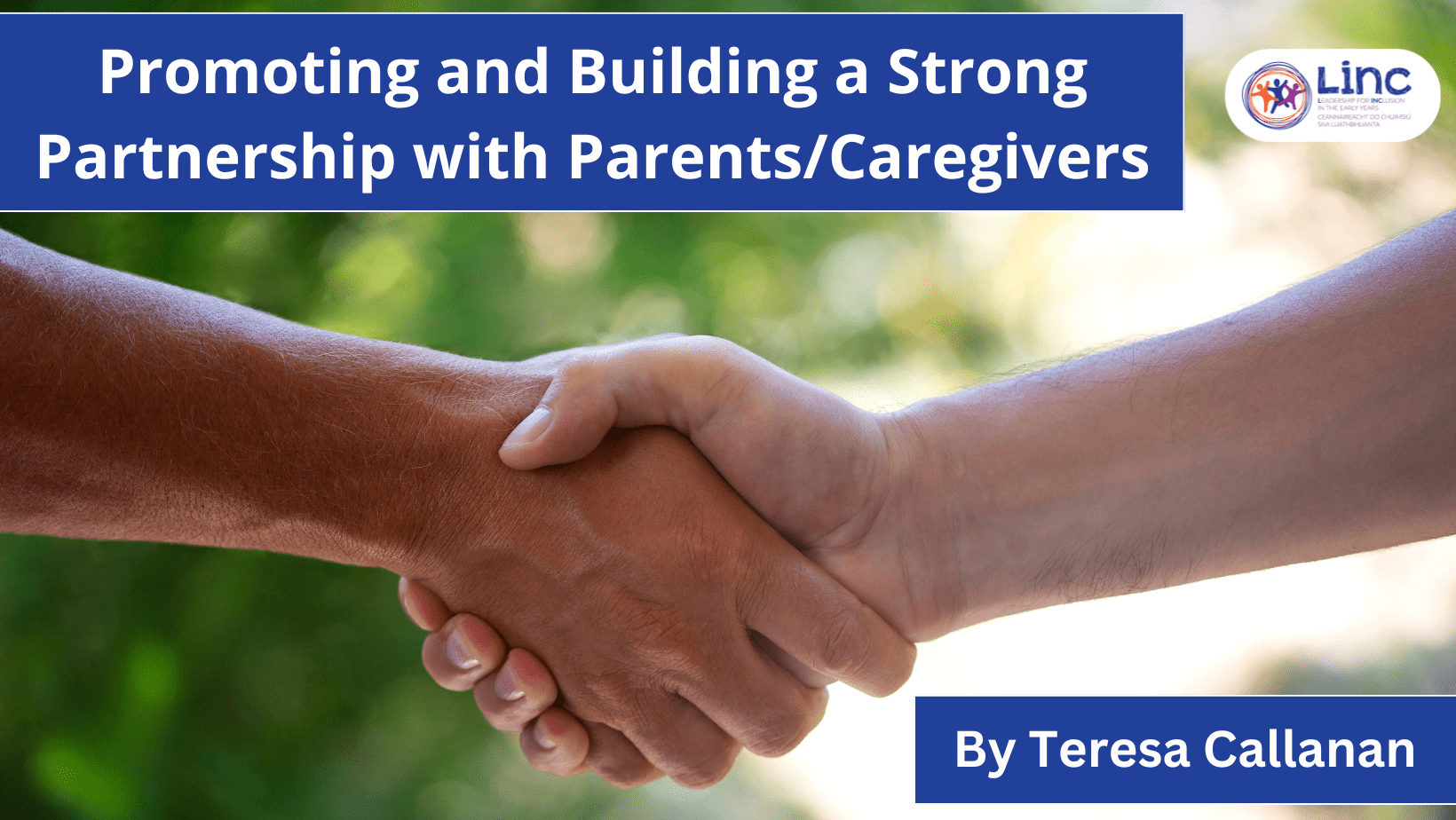
As the school year progresses, it is crucial to reflect on the partnerships and relationships formed with the children and their families. While the primary partnership is with each child, the equally vital connections with parents/caregivers enhance the holistic development of the child. Reflective tools such as those in the Aistear Síolta Practice Guide (NCCA 2015) can provide prompts to support educators in reflecting on the strengths of their partnerships.
The Significance of Parent/Caregiver Partnership:
It is almost impossible to put into words the importance of the partnership with parents/caregivers and how crucial it is to the holistic development of the child. The parent/caregiver is the child’s primary caregiver and educator, they are the ones who know the child, they are the ones who are with them the most, they are their safe place. Delivering a high-quality service is dependent on the effective communication and collaboration between early childhood settings and parents/caregivers (Gov of Ireland, 2019). Without consistent two-way communication between home and preschool, we cannot truly meet the current needs and wants of the child; we as educators cannot truly know the child at all. We only get to see such a small piece of the child when they are with us.
Theoretical Foundation:
Theories such as Bronfenbrenner’s Ecological Systems Theory (1979) and Bowlby’s Attachment Theory (1969), suggest that every environment the child encounters and every attachment he/she forms has an impact on his/her development. This is yet another reason for us to put the child at the centre of what we do, to put them at the centre of this partnership with parents/caregivers. We must always remember to also put them at the centre of the relationship between home and preschool; the child should always be the centre focus.
Insights through Communication:
We do not get to see the child outside the setting; we do not get to see their home lives; we do not always get to see their true selves. Likewise, the parent/caregiver does not get to see what the child is like at preschool, and it is not very often that the child will say what they did at preschool that day, it is usually “I don’t know” or “I forget”! Parents possess a wealth of knowledge about their child’s unique personality, preferences, and learning dispositions. By actively involving parents in the educational process, we, as educators, gain invaluable insights that can be used to tailor learning experiences to suit each child’s individual needs.
Setting the Foundations through an Open-Door Policy:
We foster an open-door policy with the parents/caregivers in my setting. We are always there to listen, to offer guidance, to offer support—for both parents/caregivers and children. We always get to know the parents/caregivers and ensure them from the start that anything they say to us about their child is treated with the utmost empathy and confidentiality. We let them know we are always there, for the big things and little things at a time that is right for them, in a private, safe space.
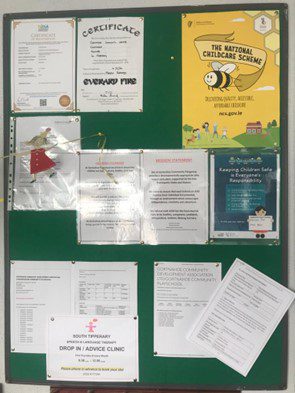
Our notice board with lots of information for the Parents/Caregivers
Respectful Partnerships:
When children start in our setting, we make a giftpack for each parent/caregiver. This small gesture helps the partnership to grow and blossom, while also acknowledging the journey parents are now travelling on.
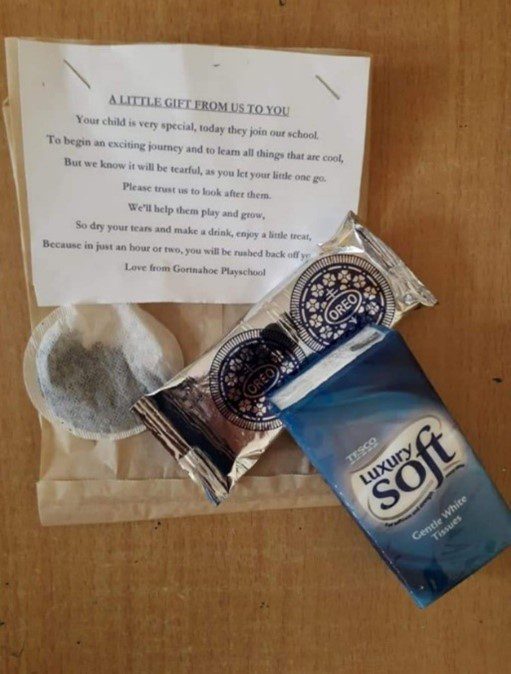
Gift pack given to the Parents/Caregivers on the first day of school
Friendship Flower:
While as Educators we are developing a partnership with parents, the children are also developing peer relationships. In our setting, we create our Friendship Flower with the children. We discuss the importance of kindness and helping each other and how ways we can help our friendship to grow. This flower is displayed in the entrance hall and provides a lovely talking point each day. It also gives children a visual reminder of our expectations around friendships.
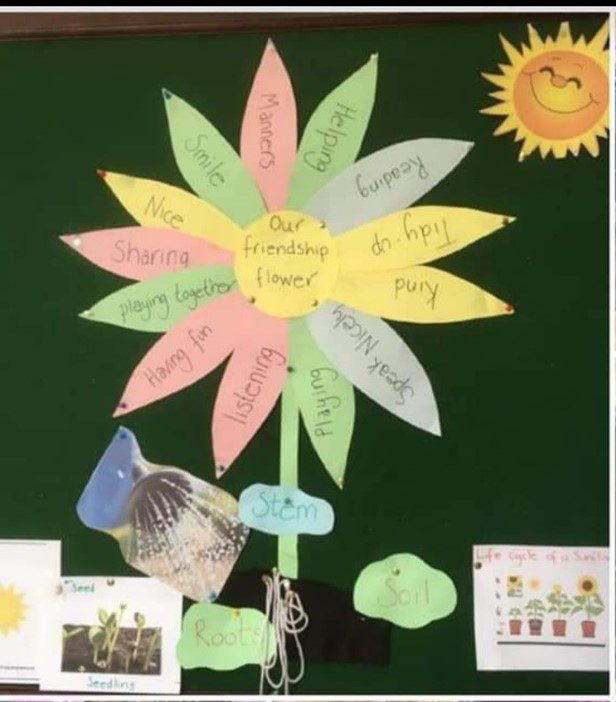
Our Friendship Flower displayed in the entrance hall
Effective Communication Channels:
I have really seen the importance of this partnership this year, not only in terms of the child’s development and well-being but also in terms of inclusion. We always try to tell the parents/caregivers every little thing about their child when they are with us. The main way we do this is through WhatsApp groups for each classroom and via phone calls and messages to individual parents/caregivers. At the start of the year, we received consent from parents/caregivers for sharing images and videos, so every day we send pictures and videos to these groups to show the parents what the children have been doing. The parents/caregivers are always delighted to see these and the feedback at collection and throughout the year is positive. We also send pictures, videos, or little notes to individual parents/caregivers too, of course, especially if a child has reached a milestone or has mastered something new. This really helps us and the parents/caregivers understand the child even better.
Partnering to Support Children’s Individual Development:
As parents/caregivers and educators see the child in different contexts, collaboration is particularly important if completing an application to AIM for support. Ideally, the Access and Inclusion Profile should be completed by both parents/caregivers and educators, either at separate times and then coming together to discuss the document, or parents/caregivers and educators can meet to complete the document together. This ensures that a full image of the child and their strengths, interests and needs are being documented. Doing this has been so effective this year for the children who need extra support and who are working with other professionals. It allows us to share and gather even more relevant information for the children and further help them to meet their full potential. It has helped us to identify these needs and get the help and support they need as quickly as possible, be it from AIM, Better Start, or from other professionals.
Through having these effective communication channels between parents and educators facilitate the early identification of any developmental, behavioural, or learning challenges a child may face. By maintaining open lines of dialogue, any concerns we may have can be addressed promptly, enabling collaborative problem-solving and early intervention. Timely support can prevent difficulties from escalating and ensure the child receives appropriate assistance to thrive academically and socially.
Other ways to communicate effectively:
Along with our WhatsApp group and meetings with parents, we also send home newsletters each term to share important dates or upcoming events, and our Facebook page allows us to share lots of exciting news and wonderful pictures of bigger events such as Christmas or when Spiderman comes to visit!
Benefits of Shared Notebooks:
This last year, we have really seen the huge benefits of using a shared notebook between home and playschool for some of the children. These methods really work well for us, and so far, we have had no issues with them, but we are always looking for better, more effective ways to make this partnership the best it can be. Communicating in this way has really made a huge difference to the children and helps us foster a close, open relationship with the parents/caregivers. This consistent two-way communication has made a huge difference to each child and has allowed us to identify and meet the children’s needs and wants much more quickly. This has impacted the children in such a positive manner in terms of their overall well-being and development.
Collaboration and Alignment of Goals:
Collaborating with parents allows us to understand and align our goals and values for the child with those of the child’s family. Open communication enables us to exchange insights about the child’s strengths, interests, and areas that require special attention. By integrating these shared goals and values, we as educators can create a consistent approach to support the child’s development at home and in the classroom.
Positive Outcomes:
There has been such a positive impact on all the children in the setting because of this strong partnership we have with the parents/caregivers. This positive impact can be seen even more in the children who have overcome so many developmental challenges during the year, who have made unbelievable progress with their communication skills and independence since the start of the year. Because we all shared information about the child, we could see what was needed, we could see what we needed to do, and most importantly, we could help and guide the child to reach his/her fullest potential—to be content and secure, to be happy and healthy. This could not have been achieved without a strong partnership with the parents/caregivers or the sharing of relevant information between us and other professionals in the child’s life. It could not have been achieved without having a trusting relationship with the parents/caregivers.
Overcoming Challenges:
We face many challenges in the work that we do, and there can often be barriers to this partnership, such as time constraints or family issues for the parents/caregiver. We need to firstly acknowledge these challenges to help to overcome them. If educators start to build partnerships with parents from the very first day, it can help to make overcoming challenges easier. It is so important to foster and build good, positive relationships with all parents.
References:
Bowlby, J. (1969). Attachment and Loss. The American Journal of Psychiatry, 97, 1158–1174.
Bronfenbrenner, Urie (1979). The Ecology of Human Development. Cambridge, Massachusetts: Harvard University Press.
Government of Ireland (2019) First 5: The Whole of Government Strategy for Babies, Young Children and their Families 2019-2028, available https://assets.gov.ie/31184/62acc54f4bdf4405b74e53a4afb8e71b.pdf [accessed 2nd Dec 2024].
National Council for Curriculum and Assessment (NCCA) (2015) Aistear Síolta Practice Guide, available https://www.aistearsiolta.ie/en/building-partnerships-with-parents/ [accessed 2nd Dec 2024]
You may also like:

LINC Shines a Light on Inclusion for the International Day of Persons with Disabilities 2025
LINC Shines a Light on Inclusion for the International Day of Persons with Disabilities 2025 The Leadership for INClusion in the Early Years (LINC) Programme marked the United Nations International Day of Persons with Disabilities (IDPD) this evening by illuminating...
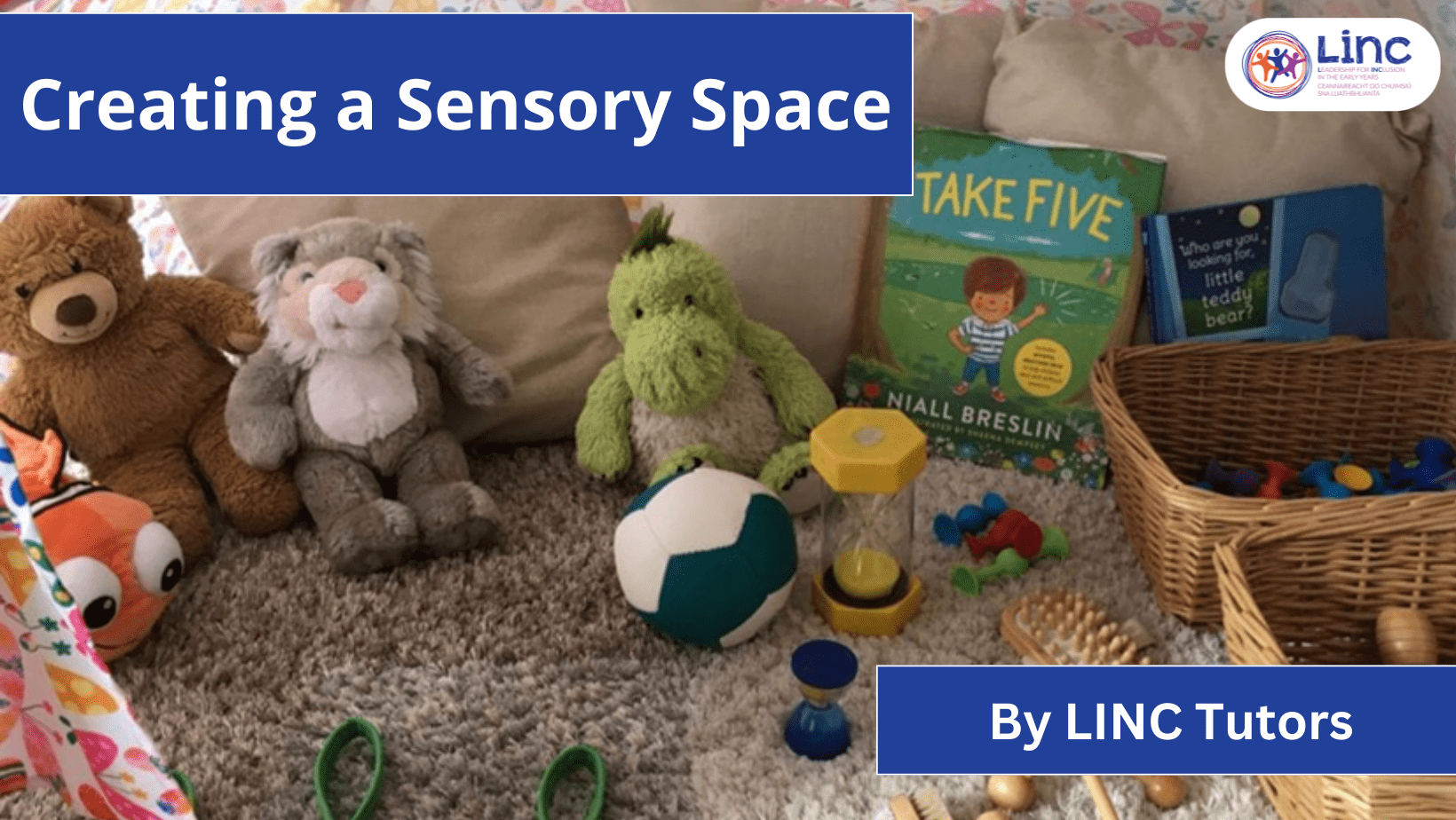
Creating a Sensory Space
Creating a Sensory Space In this edition of the LINC blog, Claire Butterly, Karina Abbott, Ann Donnellan, Carole Dee, Linda Madden, Margaret Joyce and Paula Harte highlight some considerations when planning a sensory space in your Early Learning and Care setting....
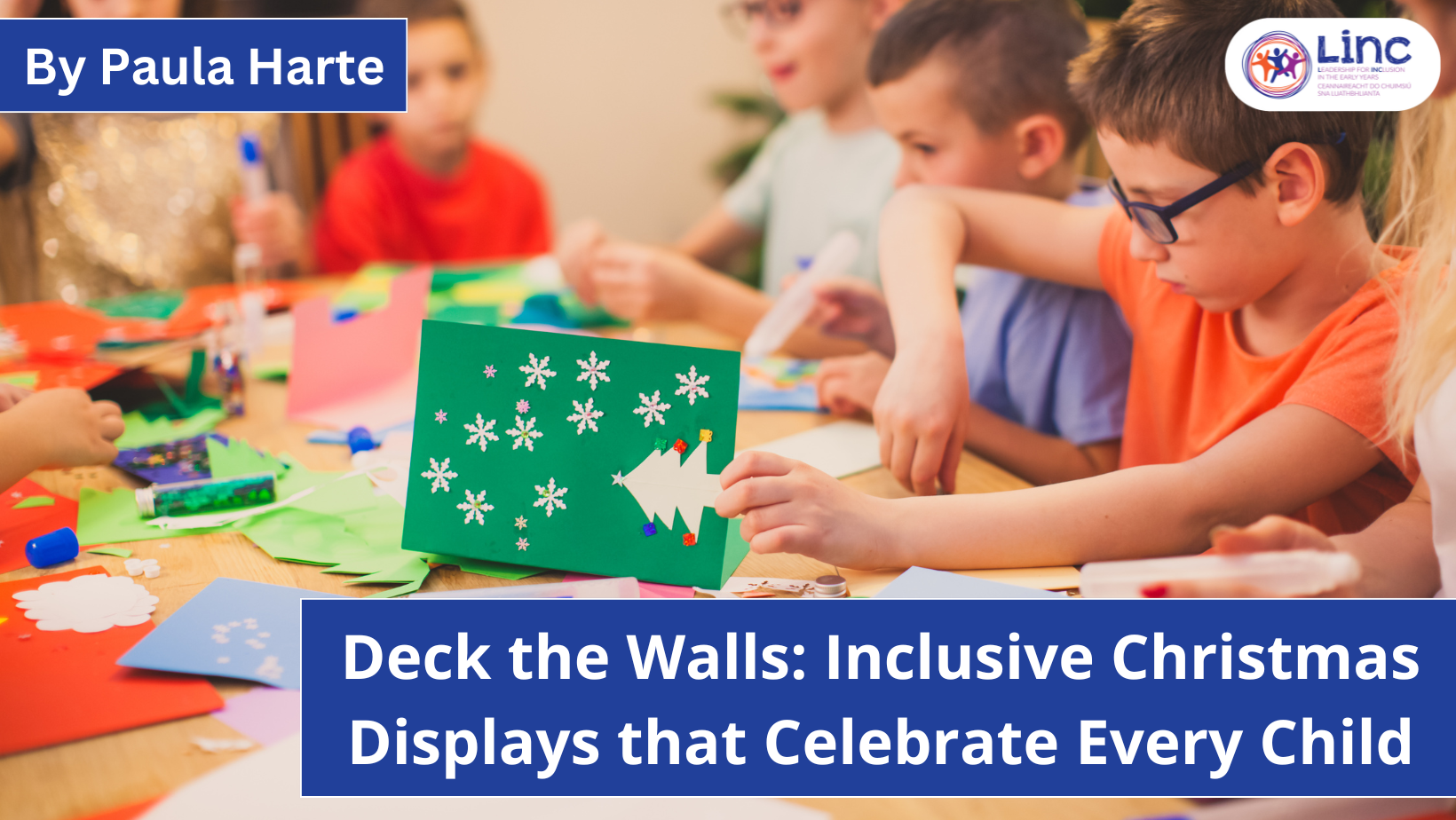
Deck the Walls: Inclusive Christmas Displays that Celebrate Every Child
Deck the Walls: Inclusive Christmas Displays that Celebrate Every Child In this edition of the LINC Blog, former LINC Tutor Paula Harte explores how Christmas displays can bring warmth, creativity, and connection to Early Learning and Care (ELC) and School-Aged...
